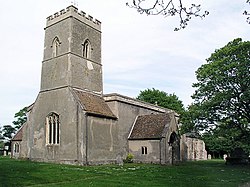Little Wilbraham
| Little Wilbraham | |
| Cambridgeshire | |
|---|---|
 St John the Evangelist, Little Wilbraham | |
| Location | |
| Grid reference: | TL546587 |
| Location: | 52°12’18"N, 0°15’47"E |
| Data | |
| Population: | 394 (2001) |
| Post town: | Cambridge |
| Postcode: | CB21 |
| Dialling code: | 01223 |
| Local Government | |
| Council: | South Cambridgeshire |
Little Wilbraham is a village in southern Cambridgeshire, lying 6 miles east of Cambridge. Little Wilbraham is half a mile north of Great Wilbraham. It consists of a knot of houses around the church and the High Street stretching westward, with separated farm houses beyond at Frog End and Mill End.
It is a small village with a population of only 394, surrounded by farms and with little other employment within the village itself. The church of Saint John the Evangelist lies at the heart of the eastern part of the village.
Within the Parish of Little Wilbraham is the hamlet of Six Mile Bottom.
History
Little Wilbraham was an independent village by the time of the Domesday Book (1086), and known as Little Wilbraham by the 13th century. John Speede's map of 1610 gave its name as 'Little Wilborham' during the early 17th century.[1].
The Domesday Book of 1086 records no woodland, but 13 peasants. By 1279 about 40 landholders are noted, and in 1563 there were only 21 families. Under Charles II, there were some 40 dwellings and 124 adults. By the 1750s this stood at 41 families with 183 adults. The total population reached 392 in 1851 and then 412 in 1881 before falling gradually to 266 in 1951. In 2001 it stood at 394.
Nowadays, a few small farmhouses and cottages survive from the 17th and early 18th century including White Hall, as timber framed building from around 1600. Since 1800, there has been a divide in habitation in the village. To the east, on a street called Green Street by 1460, lay the rectory and the church whilst to the west, as section called Hawk Street, most of the farmhouses and cottages existed. The Gate, originally the main village public house, recorded from 1783, closed after 1937. The Hole in the Wall, however, is still open today in a 3 bayed, mid 16th century building, enlarged westward in the 18th century.[2]
There are no shops in the village and the nearest Post Office is in Great Wilbraham, there is however a small pub and a post box. Many villagers also play in the local cricket and football teams based in the nearby village of Great Wilbraham.
St. John the Evangelist
The main body of St. John's Church in Little Wilbraham dates from the mid 13th century. The first known rector of the church was Walter, son of William, who lived around 1230. Late in the 13th century, the north aisle was added, probably originally as a chapel. On the outside, set into the flint wall, are the remains of the lower half of a crusader cross and this, along with the memory of the Order of the Templars, demonstrates the close links between the village and one of the Military Orders of the Crusading period. The fourteenth century saw major changes to the church. Early in the century, the square tower was added at the west end, strengthened by supporting abutments or flying arches. On the north side, the wall was reconstructed so the top half of the crusader cross was lost. New windows were built in. Nearing the end of the century, five ornate windows were also added.
In the fifteenth century, the south side of the chancel was reconstructed and the oak door leading into the church was added. The octagonal font to be found in the church is a remarkably well preserved example of perpendicular stone-work. The church at this time would have looked very similar to how it looks today. The tomb on the left side of the altar commemorates Revd. Erasmus Lane, rector who died on 27 October 1715, aged 75. In the chancel are two further tombs, one commemorating William Blackwey (died 11 April 1521) and the other the Rev John Hook, fellow of Bene't College, who died on 12 August 1777.[3]
References
- ↑ John Speede. Old Map of Cambridgeshire - Circa 1610.
- ↑ British History Online
- ↑ Little Wilbraham Church Guide